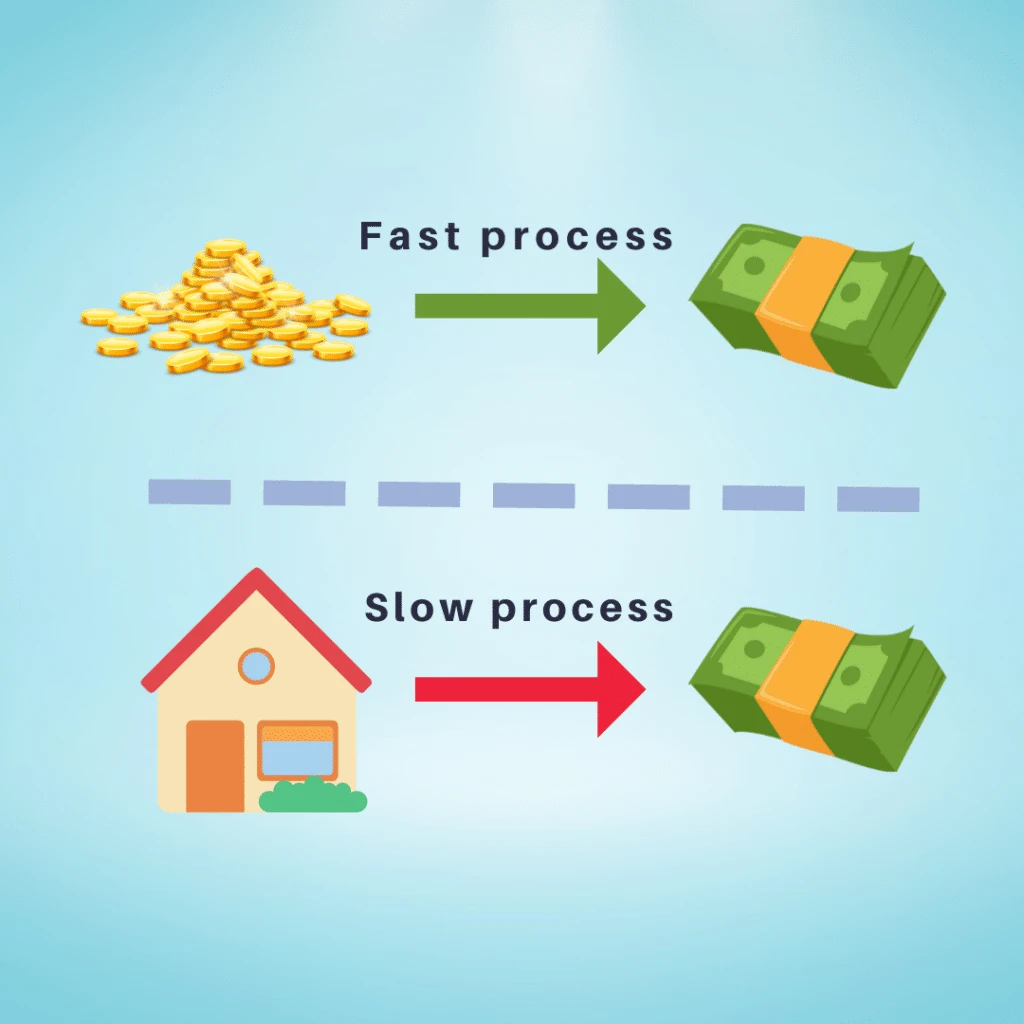What is Liquidity?
Liquidity refers to the ease with which an asset can be converted to cash without incurring a significant loss of value. In crypto, it refers to the availability of an asset to trade.
The Long Answer:
Liquidity describes how effectively an asset or security can be sold for cash without its value changing. Traditionally, cash is considered the most liquid asset, and so, an asset’s liquidity is measured in comparison to it.
Certain assets, like real estate, collectibles, or fine art are highly illiquid because they can take several months or years to sell. All other assets, like securities, trusts, stocks, and crypto, are at various other places on the liquidity scale.
Liquidity can have a slightly different description in crypto, but the concept is largely the same. In the world of cryptocurrencies, people primarily deal in crypto assets. They trade assets for cash or exchange them for other assets.
Therefore, liquidity is described as the availability of an asset to trade. The more available a crypto asset is, the easier it can be converted to cash or other assets without significant changes to its value.

Liquid Vs. Illiquid in the Real World
Let’s say that you want to buy a used car that costs $5,000. Cash is the most effective and widely accepted medium you can use to make your purchase, but you don’t have enough of it. You know the car is going to sell quickly, so you only have a few days to get enough cash together.
While you may not have cash, you do have a collection of gold you keep in a safe deposit box. So, you take it out and sell it to a nearby jewelry shop to get the $5,000 you need.
You are able to do this because gold is considered highly liquid. No matter where you are, you can usually sell your gold the same day. Other precious metals and gems, like silver and diamonds, have similar liquidity.
Now let’s look at a slightly different scenario:
Let’s say you have the same issue: you want to buy the car, but you don’t have enough cash. What you have this time (instead of the gold) is a small piece of real estate. It’s about three acres of land in a rural area. It’s definitely worth $5,000 today — but how quickly can you sell it?

Because the area that the land is in isn’t highly populated, not many people are interested. It could take months to sell. And by the time you sold the land, the car you wanted would likely be long gone. Furthermore, because it took months to sell, the price of land has dropped. Your $5,000 parcel of land has now dropped in value to only $4,000.
This happens because land (and real estate in general) is highly illiquid.
Market Liquidity Vs. Accounting Liquidity
Not surprisingly, there are different types of liquidity for different scenarios. The two main types you’ll encounter are market liquidity and accounting liquidity.
Market Liquidity
Market liquidity describes how well a market (such as a state’s transportation market or a city’s real estate market) allows assets to be exchanged at transparent, stable prices.
Let’s take a country’s stock market for example. Stock markets usually have high liquidity, allowing sellers to exchange their stocks for cash whenever they need to. So long as the exchange has a decently high volume of trade and isn’t dominated by sellers, the price a buyer is willing to pay and the amount a seller is willing to take stay relatively close to each other.
While the stock market is in this state of equilibrium, sellers don’t have to sacrifice their potential gains to make a quick sale. Instead, the price for their stock is paid quickly by willing buyers.
As such, smaller differences between preferred buying and preferred selling prices indicate a more liquid market.
This same concept applies to crypto exchanges, which are the markets for cryptocurrencies. An exchange with a high volume of trade and a sort of equilibrium between buyers and sellers is considered highly liquid.
Accounting Liquidity
Accounting liquidity is important for any firm/business. Rather than being market-focused, this type of liquidity centers around debt repayment. In other words, it measures how quickly an individual or organization can repay its debts/financial obligations with the assets it owns. If an entity lacks accounting liquidity, it is likely to collapse.
So, how does this apply to crypto?
Most crypto firms take deposits from investors. There are also those that borrow loans from other crypto firms. Firms that take deposits are obligated to pay when investors request withdrawals. Similarly, those that take loans have an obligation to pay when the loan matures.
In 2022, a chain of unfortunate events beginning with the bear market meant that several crypto companies were unable to meet their obligations. For example, Three Arrows Capital was unable to its debts to Celsius, causing it to collapse. Celsius, on the other hand, has used customer deposits to give out these loans. So as a result, it too lacked the liquidity to pay investor withdrawals, causing it to collapse.

Measuring Liquidity
Naturally, measuring an item or market’s liquidity can get complicated quickly. There are many different liquidity ratios you can measure, and each has its own unique formula. When using these formulas, you want an asset to have a liquidity ratio greater than 1.
Current Ratio
The current ratio is the least strict and simplest method of calculating liquidity. It measures your current assets (those that can reasonably be converted to cash in less than a year) against your current liabilities
It is calculated using the following formula:
Current Ratio = Current Assets ÷ Current Liabilities
Quick Ratio (Acid Test Ratio)
The quick ratio, otherwise known as the acid test ratio, is much more strict than the current ratio. In this version of liquidity measurement, you must exclude inventories and other assets that are considered relatively illiquid.
Use this formula for the acid test ratio:
Acid Test Ratio = (Cash and cash equivalents + Short Term Investments + Receivables) ÷ Current Liabilities

Acid Test Ratio Variation
Because the original acid test ratio is so strict, there is a version that gives you more wiggle room for your assets. In this version, you only leave out your inventory items and prepaid costs. This way, you get to include your more illiquid assets in your calculations.
Use the following formula for the acid test ratio variation:
Acid Test Ratio (variation) = (Current Assets – Inventories – Prepaid Costs ) ÷ Current Liabilities
Cash Ratio
The most strict ratio for measuring liquidity is the cash ratio. This version only allows you to use cash and cash equivalents – such as U.S. Treasury bills or certificates of deposit (CDs) – to measure your liquidity. This ratio is used to determine a company or individual’s ability to respond to an unforeseen event with only the assets that are immediately available to them.
Calculate your cash ratio like this:
Cash Ratio = Cash and Cash Equivalents ÷ Current Liabilities
Using these ratios and the information from this article, you can hold a better understanding of your financial position given your liquid and illiquid assets. This can help you prevent a liquidity crisis in the future and help you maintain a safe ratio of liquid to illiquid assets.
